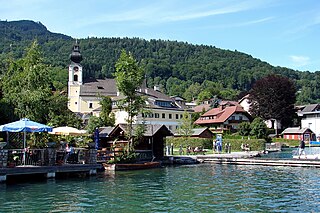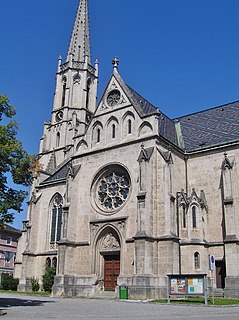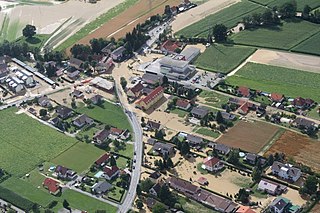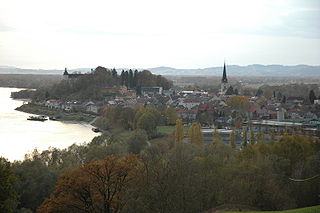
Ansfelden is a town in the Austrian state of Upper Austria. The rivers Traun and Krems run through the municipality. The town is perhaps best known for being the birthplace of the composer and organist Anton Bruckner.

Steyr is a statutory city, located in the Austrian federal state of Upper Austria. It is the administrative capital, though not part of Steyr-Land District. Steyr is Austria's 12th most populated town and the 3rd largest town in Upper Austria.

Bischofshofen is a town in the district of St. Johann im Pongau in the Austrian federal state of Salzburg. It is an important traffic junction located both on the Salzburg-Tyrol Railway line and at the Tauern Autobahn, a major highway route crossing the main chain of the Alps.

Trattenbach is a village in Austria, situated in Lower Austria. It is in the industrial part (Industrieviertel) of Lower Austria. The village's total area is 30.91 km2 (11.93 sq mi), of which 81.31% is forested.

Sankt Lambrecht is a market town in the district of Murau in Styria, Austria. It is known for St. Lambrecht's Abbey, one of the most important Benedictine monasteries in Austria. The monastery complex and its gardens are part of the Zirbitzkogel-Grebenzen nature park.

Unterach is a village in the Austria state of Upper Austria on the southern shore of lake Attersee in the centre of the Salzkammergut region.

For the town in Germany, see Mistelbach, Bavaria.

Bad Hall is a market town in the Steyr-Land district of the Austrian state of Upper Austria. Its name, Bad Hall, means "salt bath," a reference to its long history of baths and spas. It is renowned for its saline springs, strongly impregnated with iodine and bromine. Although the springs have been known since the 8th century, Hall has been noted for them only since 1855, when the springs became the property of the government.

Dellach is a municipality in the district of Hermagor, in the Austrian state of Carinthia.

Haidershofen is a town located in Austria. The town is within the district of Amstetten, located in Lower Austria.

Alland is a market town in the district of Baden in the Austrian state of Lower Austria.

Heiligenkreuz is a municipality in the district of Baden, in the Austrian state of Lower Austria. It is known for the Cistercian monastery of Heiligenkreuz Abbey, the associated papal college Benedict XVI and the Catholic Leopoldinum seminary.

Ranggen is a municipality in the district of Innsbruck-Land in the Austrian state of Tyrol located 12 km west of Innsbruck. The location was mentioned as “Fergen” in 1482 for the first time. Ranggen has 17 parts.

Hüttschlag is a municipality in the district of St. Johann im Pongau in the Austrian state of Salzburg.

Windischgarsten is a municipality in the district of Kirchdorf an der Krems in the Austrian state of Upper Austria. Since 1964, the town has been classified as a Luftkurort, a mountain spa town.

Aschach an der Steyr is a municipality in the district of Steyr-Land in the Austrian state of Upper Austria.

Garsten is a municipality in the district of Steyr-Land in the Austrian state of Upper Austria.

Weyer is a municipality in the district of Steyr-Land in the Austrian state of Upper Austria.

Ottensheim is a municipality in the district of Urfahr-Umgebung in the Austrian state of Upper Austria. In July 2008 it hosted the World Rowing Championships, and it did so again in 2019.

Pischelsdorf am Kulm is since 2015 a municipality in Weiz District in Styria, Austria. The area of the town covers 28.14 square kilometres (10.86 sq mi). In the Styria municipal structural reform, the new town was formed by merging Pischelsdorf in der Steiermark with the smaller villages of Reichendorf and Kulm bei Weiz, to reduce costs and ease election of town officials.


















